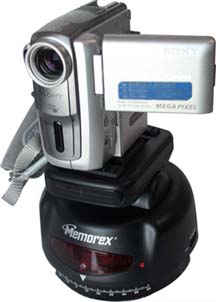Hack 10. Control Your Camcorder Remotely
| < Day Day Up > |
|
It isn't difficult to control every aspect of your camcorder from some distance away. In fact, you can shoot video without having to touch your camcorder . Sometimes, you need to take the camcorder out of your hand and stick it somewhere. For instance, you might be trying to film an animal that doesn't like people, or you might want to film a party from the far corner of a room, while remaining in the shot yourself. Whatever the reason, being able to control the camcorder remotely makes recording more flexible. 1.11.1. Replacing the RemoteMost camcorders come with a remote control that allows you to control many of the features they offer remotely. But these remote controls aren't generally that good; many of the ones I've used worked only from a few feet away. Fortunately, there are ways to get around this limitation: use a programmable remote control or use an infrared (IR) extender. 1.11.1.1. Programmable remotes.As the name implies, programmable remote controls are smarter than the average remote. They can learn the special codes that camcorder understands, allowing you to control the camcorder without the original remote. The more sophisticated models, such as the Philips Pronto range (http://www.pronto.philips.com/), can be programmed by a PC and configured to control several devices. These remotes can even string several commands together in a macro, so, you could, for instance, create a macro to switch the camcorder to low light mode and start recording from one touch of the remote a big timesaver. Programmable remotes can be a real boon if you've lost the remote, because many web sites offer downloadable configuration files for a huge range of devices. Check out sites such as Remote Central (http://www.remotecentral.com). The IR emitters in these remotes are also usually much stronger than the ones in the remote that came with the camcorder, which means that you can control the camcorder from further away. 1.11.1.2. IR remotes.IR remote controls work only where there is a line of sight, and that's not much use if you are in one room and the camcorder is in another. Fortunately, there is another simple solution: add an IR extender, such as the SmartHome 8220A (http://www.smarthome.com/8220A.html; $50). IR extenders have two parts: a transmitter that picks up the IR signal from the remote and converts it to a radio signal, and a receiver that takes this radio signal and converts it back to infrared, which the camcorder picks up. By using radio signals, they can send remote control commands through walls or other obstacles. If you are comfortable with a soldering iron, it's not difficult to build one yourself. You'll find plans for several different IR extenders at http://www.mitedu.freeserve.co.uk/Circuits/Interface/candi.htm. 1.11.1.3. Combining the best of both worlds.If you combine a programmable remote with an IR extender and a wireless video transmitter, you've got a remote control camcorder that you can easily put somewhere, and then retire to a nearby location to watch the video. And you can even control the camcorder, zooming in and out and stopping and starting the recording as required. 1.11.2. Adding a Remote-Controlled Pan and TiltWhile you're building the ultimate remote-controlled camcorder, why not add the ability to pan and tilt the camera? You can do this with a remote-con-trolled pan and tilt head: a device that fits under the camcorder and allows you to pan the camcorder left and right or tilt it up and down. I picked up a Memorex Pan-O-Matic on eBay. It can pan 120 degrees left to right and up and down 20 degrees, and it comes with a remote control. When combined with the programmable remote (programmed to control the pan and tilt head, as well as the camcorder) and the IR extender, I have a fully controllable camcorder that could pan and tilt for maximum coverage. It also runs off batteries and fits onto a tripod to make it even easier to mount and use. Figure 1-14 shows my personal setup. Although the particular model I use is no longer manufactured, there are other wireless pan and tilt heads available, such as the X10 (yes, they are the people behind all of those annoying web ads) Ninja Pan Tilt head (http://www.x10.com/products/x10_vk74a.htm; $99.00). This one uses a radio remote control, so you won't need to use the IR extender to control it.
Secondhand pan and tilt heads from CCTV system also pop up on eBay a lot. You could pick up one for less than $40. However, most of them are wired models, in which you need to run a cable between the pan and tilt head and the controller. If you buy one, make sure that it comes with the controller and that you are confident about wiring it up. Figure 1-14. Sony Camcorder on a Memorex Pan-O-Matic base Richard Baguley |
| < Day Day Up > |
EAN: 2147483647
Pages: 158
